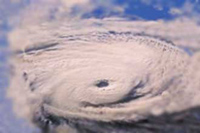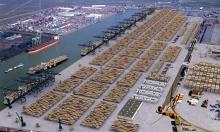The coming season of hurricanes may have fatal consequences for the USA
Each country has its distinctive climatic features. And to tell the truth some of these features can be very dangerous. In the USA the most dangerous climatic feature is hurricanes. The last season of hurricanes showed that American authorities were not well prepared to fight the consequences of hurricanes. Even on today’s photos of New Orleans one can see the traces Mother Nature’s power.

Today forecasters are warning that a hurricane making landfall at or near New York City could cause catastrophic damage in the US's largest urban center.
While a storm is unlikely to make direct landfall on Manhattan, a nearby storm would cause extensive flooding and heavy storm surges, experts say.
Even a minimal hurricane could put the runways at John F. Kennedy Airport underwater, and the battering action of wind-driven waves could cause significant damage to buildings, says Stephen Baig, a storm surge specialist with the National Hurricane Center in Miami.
A minor hurricane could also cause flooding throughout Lower Manhattan, depending on how the storm approached and whether it arrived at high or low tide.
Making matters worse, many New York residents may not realize how severely they could be affected by a hurricane.
Scott Mandia, a professor of physical sciences at Suffolk County Community College in Selden, says Long Island 's 4 million residents could be surprised by the aftermath of a storm.
"What I think they don't understand is how many days and weeks after a hurricane that their lives will be completely changed," Mandia said.
"People who live away from the water think a hurricane will mean one day away from work, then back to normal."
"There will be an economic shutdown for a few weeks, if not a month," he said. "The economic standstill will be the biggest surprise for people."
Gregory Caronia, director of emergency preparedness for Nassau County on Long Island, said he tells Nassau County residents to be prepared to survive for at least four or five days on their own after a hurricane.
"We have so many people here and limited resources," Caronia said.
"Response within hours is not feasible. Within eight hours after a hurricane, we might be able to get some sort of reconnaissance [of the damage]. Beyond that, it might be a day or two or three before we can get help to them."
Forecasters also warn that a hurricane striking New York City could cause major problems well beyond the city itself.
"We've come to realize since Hurricane Katrina that a major hurricane near an urban center can have national and international repercussions," said Nicholas K. Coch, a professor of environmental sciences at Queens College in New York City .
New Orleans, one of the nation's most important ports, was devastated last August by Hurricane Katrina. The destruction contributed to a sharp increase in oil prices, and the city is still struggling to recover.
New York, a worldwide financial center, has an even larger presence in national and international commerce.
Should a hurricane close the port of New York and the New York Stock Exchange for a week or more, the damage to the nation's economy would be more severe than that caused by Katrina, Coch said.
And although New York isn't typically associated withhurricanes,the city has taken hits in the past and is vulnerable to storm surge.
A 1990 study by the U.S. Army Corps of Engineers said the three U.S. cities most vulnerable to hurricanes are New Orleans , Miami , and New York , according to The National Geographic.
Is U.S. Ready for Hurricane Season?
U.S. disaster-preparedness officials declared themselves ready yesterday for the June 1 onset of hurricane season, amid mounting anxiety in Gulf Coast states hit by last year's devastating storms that recovery efforts and repairs to the nation's emergency response system remain incomplete.
Federal authorities have stockpiled four times as much food and ice as they had before hurricanes Katrina and Rita struck last year, supplies capable of sustaining 1 million people for at least seven days, Homeland Security Secretary Michael Chertoff and top U.S. military commanders said at a news conference. The government has also spent $800 million improving National Guard communications and has forged the closest civilian and military disaster response command structure ever, they said.
"We are . . . much more prepared as a nation than we have ever been to confront a major hurricane," Chertoff said. He called on the nation's 60 million coastal residents to prepare their families for disasters and to heed any warnings that authorities issue.
But the claims came with hundreds of thousands of displaced victims from last year's hurricanes still living in more than 100,000 trailers in Louisiana and Mississippi, creating the potential for a new evacuation and housing crisis if another storm strikes. States and the Federal Emergency Management Agency are rushing to overhaul the tracking and movement of disaster supplies, but efforts are uncoordinated, state leaders warn.
FEMA's hurricane operations plan is unfinished, state officials said, and the agency remains 15 percent understaffed. Repairs to New Orleans's levee system by the U.S. Army Corps of Engineers are incomplete, and a state commission recently warned that 40,000 Floridians could face a catastrophic flood if a storm hits weakened flood-control systems near Lake Okeechobee.
Mindful of Katrina's toll of more than 1,800 lives, $100 billion in U.S. taxpayer-funded losses and the political standing of President Bush, federal officials have embarked on a campaign to educate residents in hurricane country about preparedness in the days leading up to June 1. They are also trying to mend the image of homeland security agencies and implement hundreds of recommendations from blistering congressional and White House inquiries.
"Last year we didn't have a clue," said the acting FEMA director, R. David Paulison. The agency will put satellite tracking devices on trucks leaving its two largest logistics centers -- in Denton, Tex., and Atlanta -- to avoid a repeat of post-Katrina efforts, when critical supplies such as ice and generators arrived days or weeks late, sometimes after circling the country.
FEMA will test streamlined command procedures with states over the next two weeks, after evacuation drills yesterday in Louisiana and recently in Texas, Mississippi and elsewhere, Chertoff said, according to The Washington Post.
Prepared by Alexander Timoshik
Pravda.ru
Subscribe to Pravda.Ru Telegram channel, Facebook, RSS!




